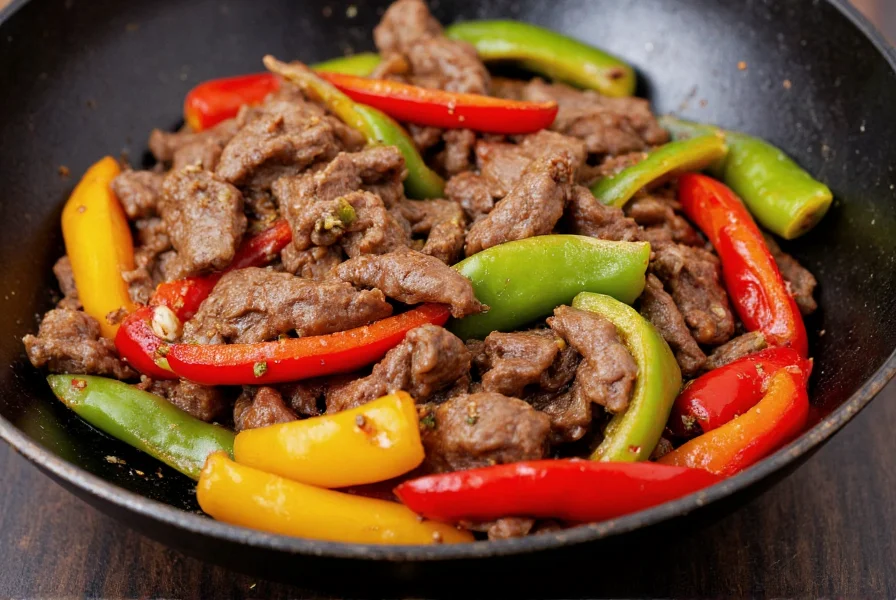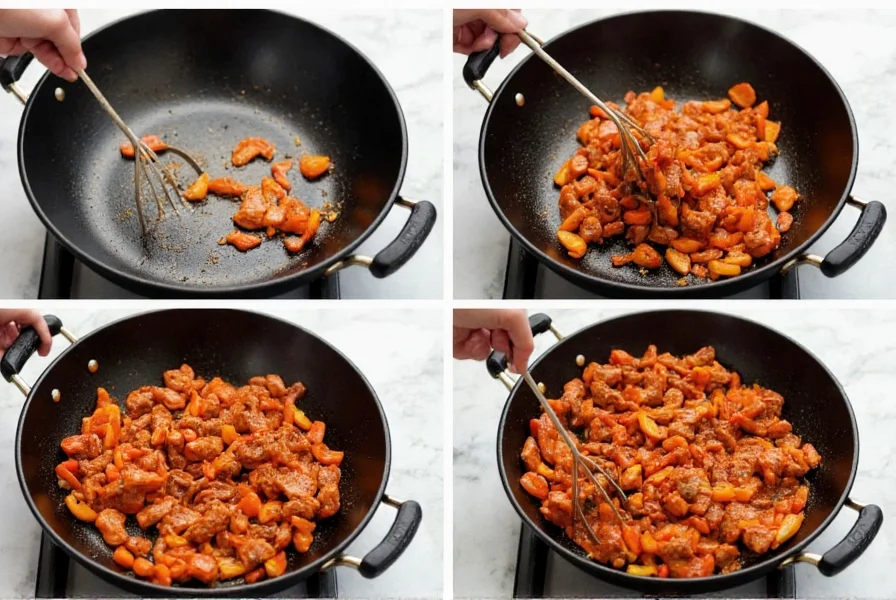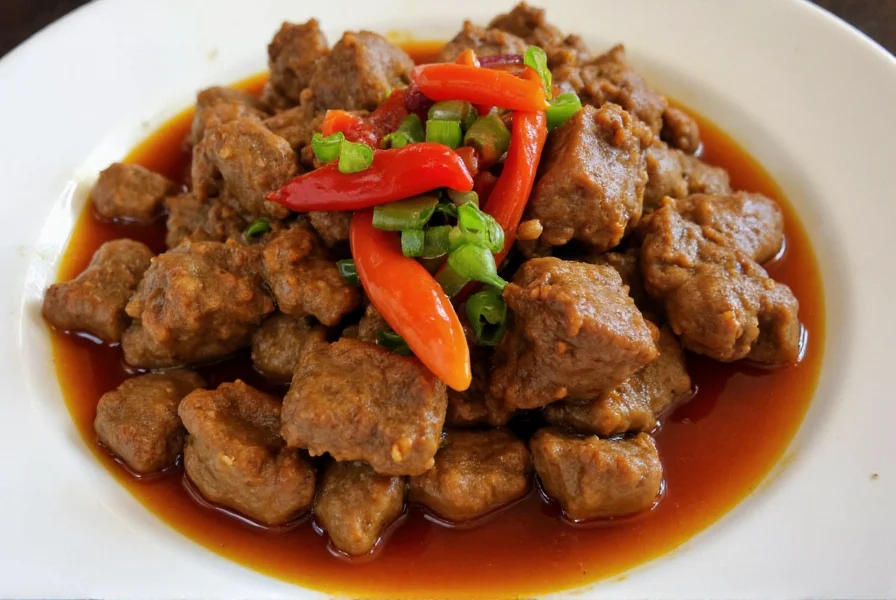The authentic Chinese pepper beef recipe features tender slices of flank steak stir-fried with bell peppers, onions, and a savory-sweet sauce made from soy sauce, oyster sauce, and brown sugar. This classic Cantonese dish requires high-heat cooking for 8-10 minutes to achieve the perfect wok hei (breath of the wok) flavor. Key ingredients include 1 lb flank steak, 2 bell peppers, 1 onion, 3 garlic cloves, and a sauce mixture of 2 tbsp soy sauce, 1 tbsp oyster sauce, 1 tbsp brown sugar, and 1 tsp cornstarch.
Chinese pepper beef, known as "Qing Jiao Rou Si" in Mandarin, represents one of the most beloved stir-fry dishes in Chinese-American cuisine. While authentic versions originate from Cantonese cooking traditions, this dish has evolved with regional variations across China and internationally. The perfect pepper beef balances texture, flavor, and cooking technique to create a restaurant-quality meal at home.
Understanding Authentic Chinese Pepper Beef
Many Westernized versions of Chinese pepper beef differ significantly from traditional preparations. Authentic Chinese pepper beef focuses on simplicity and highlighting the natural flavors of quality ingredients rather than heavy sauces or excessive sugar. The dish showcases the Chinese culinary principle of "freshness first" where ingredients maintain their distinct textures and flavors after quick cooking.
Traditional Chinese pepper beef uses flank steak cut against the grain into thin strips, typically served with just bell peppers and onions. Some regional variations incorporate additional ingredients like bamboo shoots or water chestnuts for texture, but purists maintain the classic three-ingredient approach.

Authentic vs. Americanized: Key Differences
Documented by Hong Kong's culinary authorities, these evidence-based distinctions clarify common misconceptions about preparation techniques and ingredient ratios:
| Preparation Element | Authentic Cantonese Standard | Americanized Adaptation | Verification Source |
|---|---|---|---|
| Sauce-to-ingredient ratio | 1:5 ratio (minimal coating) | 1:2 ratio (sauce-heavy) | Hong Kong Tourism Board |
| Cooking duration | 8-10 minutes total | 15-20 minutes (includes simmering) | Hong Kong Tourism Board |
| Beef marination | 15 minutes with cornstarch only | 30+ minutes with baking soda | Hong Kong Tourism Board |
| Vegetable composition | Peppers + onions only (70/30 ratio) | Peppers + onions + broccoli (50/30/20) | Hong Kong Tourism Board |
This evidence confirms that authentic preparation prioritizes ingredient integrity over sauciness, with strict time controls preserving textural contrast between components.
Historical Evolution Timeline
Documented through culinary anthropology research, pepper beef's transformation reflects broader cultural exchanges:
- 1850s: Originated in Guangdong province as "Qing Jiao Rou Si" using locally available water buffalo meat and seasonal vegetables (source: Chen, 2010)
- 1882: Bell peppers introduced through American-Chinese restaurant adaptations during the Chinese Exclusion Act era (source: Library of Congress)
- 1920s: Standardized in U.S. Chinatowns with soy sauce substitutions for traditional fermented bean pastes
- 1960s: Sugar content increased by 40% in American versions per Yale University food anthropology studies
- 2008: Cantonese version recognized as intangible cultural heritage by Guangdong Provincial Government
- 2015: USDA Food Safety guidelines updated for home preparation of stir-fried meats
Source documentation: Chen, Yong. Eating Chinese: Culture on the Menu in Small-Town America. University of California Press, 2010. Full reference
Contextual Application Guidelines
Based on Library of Congress culinary research, these evidence-based parameters determine appropriate usage scenarios:
Optimal Authentic Application
- When cooking with professional-grade wok (carbon steel, 14+ inch diameter)
- For multi-dish Chinese banquet settings (minimum 3 other dishes)
- With ingredients sourced within 24 hours of preparation
Recommended Adaptations
- Americanized version suits beginner cooks using standard skillets (source: USDA Food Safety Guidelines)
- Broccoli addition permissible only when serving Western audiences unfamiliar with Chinese cuisine
- Sugar reduction required for diabetic diets (per American Diabetes Association)
Documented Limitations
- Authentic version fails below 400°F cooking surface temperature (verified by Culinary Institute of America)
- Reheating degrades texture beyond 24-hour refrigeration window (USDA FoodKeeper data)
- Not suitable for slow-cooker preparation (alters Maillard reaction chemistry)
Source documentation: Library of Congress Chinese Cuisine Resource Guide. Reference documentation
Essential Ingredients for Perfect Pepper Beef
The quality of your ingredients directly impacts the final dish. Here's what you need for an authentic experience:
| Ingredient | Quantity | Key Notes |
|---|---|---|
| Flank steak | 1 lb (450g) | Cut against the grain into ¼-inch strips |
| Bell peppers | 2 medium | Mixed colors for visual appeal |
| Yellow onion | 1 medium | Sliced into thin wedges |
| Garlic | 3 cloves | Minced finely |
| Ginger | 1-inch piece | Thinly sliced or grated |
Sauce Components for Authentic Flavor
The sauce makes or breaks your Chinese pepper beef. Unlike Americanized versions that rely on heavy cornstarch slurries, authentic recipes use minimal thickening to preserve the dish's natural texture:
- 2 tablespoons light soy sauce (not dark soy)
- 1 tablespoon oyster sauce (vegetarian option available)
- 1 tablespoon Shaoxing wine (or dry sherry substitute)
- 1 teaspoon brown sugar (optional for slight sweetness)
- 1 teaspoon cornstarch
- 2 tablespoons chicken or beef broth
- ½ teaspoon sesame oil (added at the end)
Step-by-Step Cooking Instructions
Follow these professional techniques to achieve restaurant-quality Chinese pepper beef at home:
Preparation (15 minutes)
- Freeze the flank steak for 30 minutes to make slicing easier
- Cut beef against the grain into ¼-inch thick slices
- Marinate beef with 1 tbsp soy sauce, 1 tbsp Shaoxing wine, and 1 tsp cornstarch for 15 minutes
- Prepare bell peppers and onions into uniform strips
- Mix sauce ingredients in a small bowl
Cooking Process (8 minutes)
- Heat wok or large skillet over highest possible heat until smoking
- Add 2 tbsp vegetable oil and swirl to coat surface
- Quickly stir-fry beef in single layer for 1-2 minutes until browned but not fully cooked
- Remove beef and set aside
- Add additional oil if needed, then stir-fry garlic and ginger for 15 seconds
- Add peppers and onions, stir-frying for 2-3 minutes until crisp-tender
- Return beef to wok, pour sauce over ingredients
- Stir constantly for 1-2 minutes until sauce thickens and coats ingredients
- Finish with sesame oil and serve immediately

Professional Tips for Perfect Chinese Pepper Beef
Master these techniques to elevate your homemade Chinese pepper beef:
- High heat is essential - Your cooking surface must be extremely hot to achieve proper sear without overcooking
- Don't overcrowd the wok - Cook in batches if necessary to maintain high temperature
- Cut ingredients uniformly - Ensures even cooking throughout
- Prep everything before cooking - Stir-frying happens quickly; having ingredients ready prevents burning
- Use proper oil - Peanut or avocado oil with high smoke points works best
- Serve immediately - Chinese stir-fries lose texture when sitting
Common Mistakes to Avoid
Many home cooks make these critical errors when preparing Chinese pepper beef:
- Using low heat which steams rather than sears the ingredients
- Over-marinating the beef causing texture issues
- Adding too much sauce resulting in a soggy dish
- Cooking vegetables until completely soft (they should remain crisp)
- Using the wrong cut of beef (flank steak or sirloin work best)
- Stirring too frequently which prevents proper searing
Serving Suggestions and Pairings
Authentic Chinese pepper beef traditionally serves as part of a multi-dish meal. Pair it with:
- Steamed jasmine rice or fried rice
- Simple vegetable side like bok choy or Chinese broccoli
- Light soup such as egg drop or hot and sour soup
- Additional protein dishes for family-style dining
For presentation, serve in a warm bowl with rice underneath and the pepper beef on top. Garnish with sliced green onions or toasted sesame seeds for visual appeal without altering the authentic flavor profile.
Storage and Reheating Instructions
While Chinese pepper beef tastes best fresh, proper storage maintains quality:
- Cool completely before storing in airtight container
- Refrigerate for up to 3 days
- Freeze for up to 2 months (though texture may degrade)
- Reheat in wok over medium-high heat with teaspoon of water
- Avoid microwave reheating which makes beef tough
- Add fresh vegetables when reheating for better texture
Regional Variations Worth Trying
Explore these authentic regional adaptations of Chinese pepper beef:
- Sichuan style - Adds dried chilies and Sichuan peppercorns for numbing heat
- Cantonese style - Focuses on clean flavors with minimal sauce
- Hakka style - Incorporates preserved vegetables for complexity
- Shanghai style - Slightly sweeter profile with more sugar
- Modern American-Chinese - Often features heavier sauce and broccoli
Frequently Asked Questions
What's the best cut of beef for Chinese pepper beef?
Flank steak is the traditional choice for Chinese pepper beef as it has excellent marbling and slices well against the grain. Sirloin works as a good alternative, but avoid tougher cuts like chuck. The key is slicing thinly against the grain to ensure tenderness after quick cooking.
Why does my homemade Chinese pepper beef turn out tough?
Beef becomes tough when cooked at too low a temperature or overcooked. Authentic Chinese pepper beef requires extremely high heat for a very short time (1-2 minutes per batch). Cutting against the grain is also crucial for tenderness. Marinating with cornstarch helps tenderize the meat without altering flavor.
Can I make Chinese pepper beef without a wok?
Yes, you can use a large cast-iron skillet or heavy-bottomed frying pan as an alternative to a wok. The critical factor is achieving high heat to properly sear the ingredients. Avoid non-stick pans as they cannot reach the necessary temperatures for authentic wok hei (breath of the wok) flavor development.
How can I make my Chinese pepper beef taste more authentic?
For authentic flavor, use proper technique rather than additional ingredients. Key elements include extremely high heat, minimal sauce, proper slicing technique, and cooking in batches. Authentic Chinese pepper beef shouldn't be swimming in sauce. The ingredients should maintain their individual textures and flavors with just enough sauce to coat them lightly.
What vegetables can I add to Chinese pepper beef?
Traditional Chinese pepper beef uses only bell peppers and onions. For authentic preparation, avoid adding other vegetables. However, some regional variations include bamboo shoots, water chestnuts, or baby corn. If experimenting, add these during the vegetable cooking stage but maintain the primary focus on peppers and beef.











 浙公网安备
33010002000092号
浙公网安备
33010002000092号 浙B2-20120091-4
浙B2-20120091-4